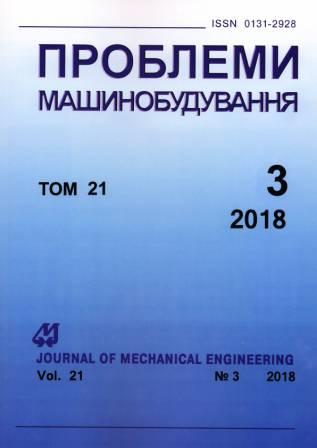Прогнозування ерозійно-корозійного зносу елементів трубопроводів атомних електростанцій методом нейромережевого моделювання
Ключові слова:
нейронні мережі, комп'ютерне моделювання, ерозійно-корозійний зносАнотація
На основі комплексного підходу, що використовує комп'ютерне моделювання процесу руйнування конструкційних матеріалів і технологію самонавчальних нейронних мереж, розроблено методологію прогнозування швидкості ерозійно-корозійного зносу (ЕКЗ) елементів трубопроводів з однофазним середовищем другого контуру АЕС. Нейромережева модель реалізована в середовищі програмування Delphi. Нейронна мережа складається з вхідного шару, що містить сім елементів, і вихідного шару з двома елементами. Як вхідні змінні нейронної мережі обрані параметри, які чинять найбільший вплив на процес ЕКЗ. Це температура середовища, внутрішній діаметр трубопроводу, вміст кисню в середовищі, швидкість течії теплоносія, водневий показник, час проведення контролю (або початку експлуатації) і час, на який здійснюється прогнозування. Для кожного з вхідних параметрів мережі вибиралися інтервали можливих значень. Проте чинники, що впливають на швидкість ЕКЗ, але не увійшли в реалізовану модель (вміст хрому, міді та молібдену в матеріалі трубопроводу, тип аміну), прийняті постійними. Вихідними параметрами нейронної мережі є швидкість ЕКЗ і зміна товщини стінки елемента трубопроводу за прогнозований часовий інтервал. Як метод навчання нейронної мережі обраний метод зворотного поширення помилки, що передбачає прямий і зворотний прохід. Навчальним алгоритмом нейронної мережі є алгоритм навчання з учителем. Для тестової вибірки пропонується, поряд з даними експлуатаційного контролю, використовувати результати розрахунків за статистичною моделлю, створеною в рамках спеціального розрахунково-експериментального методу. Встановлено принципову можливість використання нейронних мереж для прогнозування швидкості ЕКЗ в елементах трубопроводів другого контуру АЕС. Розроблений підхід дозволяє поліпшити точність прогнозу швидкості ерозійно-корозійного зносу без визначення всіх залежностей між безліччю факторів, що впливають на процес ЕКЗ. Низькі значення помилок побудованих моделей дозволяють використовувати результати розрахунків для визначення ресурсних характеристик трубопроводів з однофазним середовищем другого контуру АЕС і оптимізації експлуатаційного контролю.Посилання
Naftal, M. M., Baranenko, V. I., & Gulina O. M. (2004). Use of software tools for calculating flow accelerated corrosion of nuclear power plant equipment and pipelines. Thermal Eng., vol. 61, no. 6, pp. 456–463.
Baranenko, V. I., Yanchenko, Yu. A., Gulina, O. M., & Dokukin, D. A. (2010). O raschete skorosti erozionno-korrozionnogo iznosa i ostatochnogo resursa truboprovodov AES [Calculation of the rate of erosion-corrosion wear and residual life of NPP pipelines]. Izv. Vuzov. Yader. Energetika − Izvestia Vysshikh Uchebnykh Zavedeniy. Yadernaya Energetika, no. 2, pp. 55–63 [in Russian].
Mileshkin, M. B., & Biblik, I.V. (2006). Primeneniye spetsialnogo raschetno-eksperimentalnogo metoda dlya otsenki ostatochnogo resursa elementov konstruktsiy po fakticheskomu sostoyaniyu materiala [Application of a special calculation and experimental method for estimating the residual life of structural elements based on the actual state of the material]. Nadezhnost i Dolgovechnost Mashin i Sooruzheniy – Reliability and Life of Machines and Installations, iss. 27, pp. 304–310 [in Russian].
Mileshkin, M. B., Biblik, I.V., & Inkulis, V. V. (2009). Otsenka veroyatnosti bezotkaznoy raboty oborudovaniya AES na osnove modelirovaniya izmeneniya stepeni ekspluatatsionnoy povrezhdennosti [Evaluation of the probability of failure-free operation of NPP equipment on the basis of modeling the change in the degree of operational damage]. Nadezhnost i Dolgovechnost Mashin i Sooruzheniy – Reliability and Life of Machines and Installations, iss. 32, pp. 105–112 [in Russian].
RD EO 0571-2006. (2006). Normy dopustimykh tolshchin elementov truboprovodov iz uglerodistykh staley atomnykh stantsiy [Norms of admissible thickness of carbon steel pipeline elements of nuclear power plants]. Valid from 2006.11.01.Moscow: OAO 'Kontsern Rosenergoatom', 44 p. [in Russian].
Baranenko, V. I., Gulina, O. M., & Dokukin, D. A. (2008). Metodologicheskaya osnova prognozirovaniya erozionno-korrozionnogo iznosa oborudovaniya AES metodom neyrosetevogo modelirovaniya [Methodological basis of prediction of erosion-corrosion wear of NPP equipment by the method of neural network modeling]. Izv. Vuzov. Yader. Energetika − Izvestia Vysshikh Uchebnykh Zavedeniy. Yadernaya Energetika, no. 1, pp. 3–8 [in Russian].
Baranenko, V. I., Getman, A. F., Ovcharov, O. V., & Gusarov, A. Ye. (2006). Ispolzovaniye programmnykh sredstv dlya rascheta korrozii truboprovodov i oborudovaniya energoblokov AES [Use of software for calculation of corrosion of pipelines and equipment of NPP power units. Available at: www.gidropress.podolsk.ru/files/proceedings/mntk2017/autorun/article19-ru.htm.
Khaykin, S. Neyronnyye seti: per. s angl. [Nuron networks (trans. from English)]Moscow: Izdat. dom 'Vilyams', 1104 p. [in Russian].
##submission.downloads##
Опубліковано
Номер
Розділ
Ліцензія
Авторське право (c) 2018 Konstantin V. Avramov, Irina V. Biblik, Roman A. Rusanov

Ця робота ліцензується відповідно до Creative Commons Attribution-NoDerivatives 4.0 International License.
Автори, які публікуються в цьому журналі, погоджуються з наступними умовами:
- Автори залишають за собою право на авторство своєї роботи і передають журналу право першої публікації цієї роботи на умовах ліцензійного договору (угоди).
- Автори мають право самостійно укладати додаткові договори (угоди) з неексклюзивного поширення роботи в тому вигляді, в якому вона була опублікована цим журналом (наприклад, розміщувати роботу в електронному сховищі установи або публікувати в складі монографії), за умови збереження посилання на першу публікацію роботи в цьому журналі.
- Політика журналу дозволяє розміщення авторами в мережі Інтернет (наприклад, у сховищах установи або на персональних веб-сайтах) рукопису роботи як до подачі цього рукопису в редакцію, так і під час її редакційної обробки, оскільки це сприяє виникненню продуктивної наукової дискусії і позитивно позначається на оперативності та динаміці цитування опублікованої роботи (див. The Effect of Open Access).

